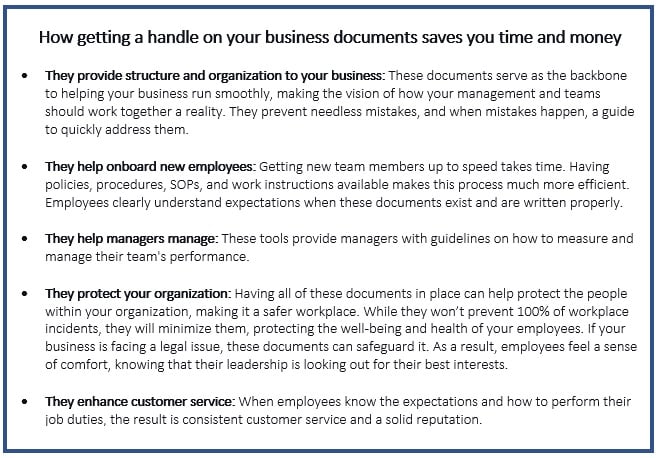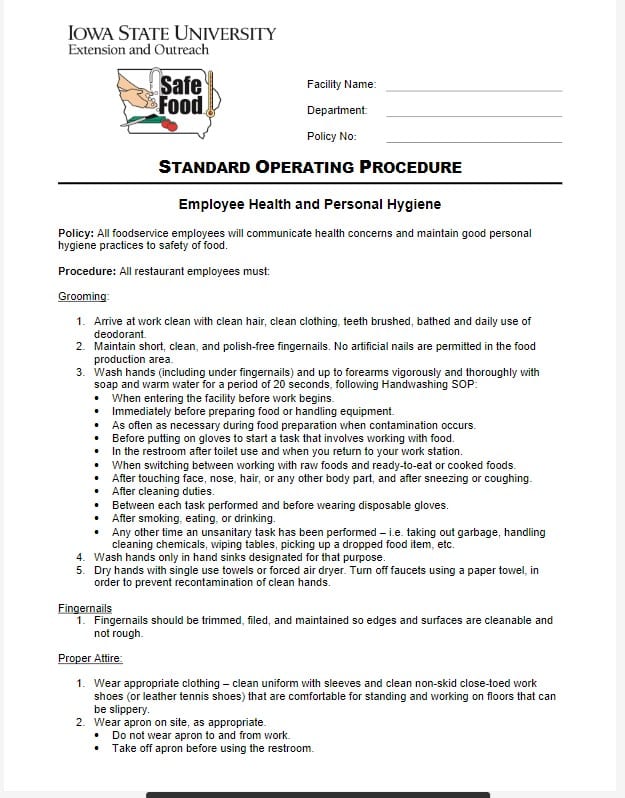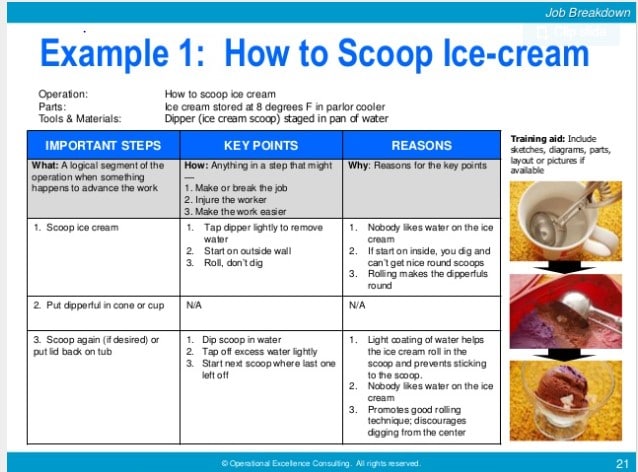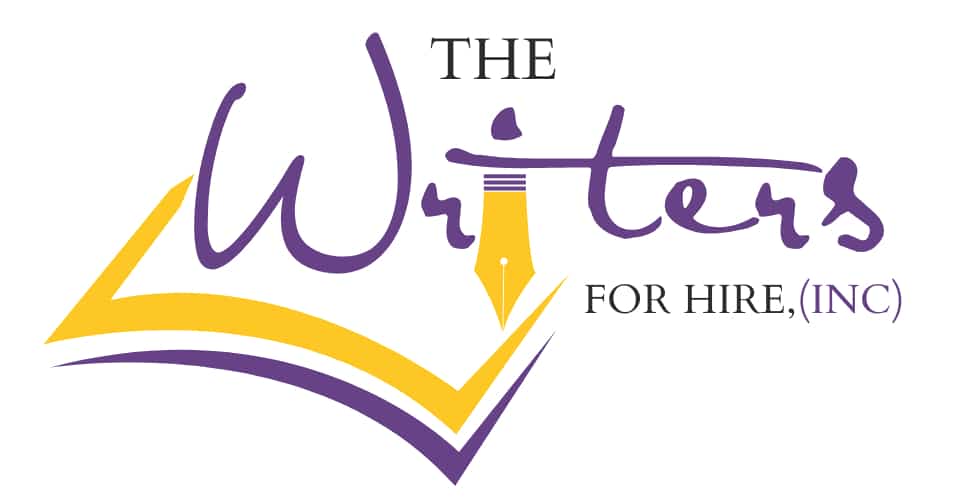Getting a Handle on your Business Documents
July 24, 2020
Policies. Procedures. SOPs. Instructions. Standards. These aren’t just fancy buzzwords tossed around the office. These are documents that, when written well and used correctly, will save you mounds of time, money, and frustration.

Defining the differences
All of these documents are different and serve various functions.
If you are not familiar with their differences and use the terms interchangeably, you run the risk of confusing yourself, your leadership, and your team.
Below are simple definitions of each of these documents and their distinctions.
All of them should be written clearly, so everyone across your organization can read and comprehend them regardless of age, position in the company, education, knowledge, or skill level.
Policies
Painting a picture of what is and what is not acceptable
Derived from the Old French term, “polici,” which means “civil administration,” policies serve as the overall guidelines to govern your business or organization.
Policies help leaders make decisions by defining what is and what is not acceptable in the workplace.
A dress code, for example, is a type of policy.
It outlines what kinds of dress are and are not acceptable in the workplace and provides management and leadership guidelines, ensuring your workforce is presentable in front of customers and clients.
Most organizations also have policies that address drug and alcohol in the workplace, as well as ones for attendance and tardiness.
Having these policies helps management decide when — and to what degree — a manager should administer disciplinary action if an employee breaks them.
Simply stated, policies allow a manager to respond to a workplace problem consistently and confidently. And, at the end of the day, help employees be more productive.
When it comes to writing a policy, there are some questions you should ask yourself:
1. Is it clear? Policy definitions need to be concise and comprehensive.
For example, if you are writing a policy about bullying in the workplace, using terms like “physical aggression, intimidation, or verbal abuse” helps paint a picture of what bullying at your company or organization looks like.
You also need to include to whom the policy applies. Is it only for staff? Or is it for volunteers and contractors?
2. Are you communicating policies effectively? A policy serves you no good if you’re not reaching your intended audience.
There are many ways to communicate your policy, including an article on your company’s Intranet, reviewing it in a town hall or other type of staff meeting, and including a link in a learning management system.
Policies are not just for new employees, either. Tenured employees should review them often as well.
3. Do they reflect your company’s core values? When writing your policies, they should reflect the values you’ve established.
They should be specific to your culture and what you expect from your team members.
Standard Operating Procedure
Providing a roadmap to success
A standard operating procedure or “SOP” acts as a roadmap for teams to follow when carrying out specific processes or a flow of activity. It provides a basis to ensure that services and products are delivered consistently.
In the pharmaceutical industry, for example, SOPs cover the proper way to carry out activities such as dispensing of medications and checking expiration dates. The SOPs help pharmacists avoid errors in getting medicines to patients, thus keeping them safe.
Without having this go-to guide, several different team members may approach the same task in several different ways.
However, if there’s a protocol in place for them to follow, the chances of them making a mistake decreases, saving you time and money.
When writing an SOP, you may want to consider including the following elements:
- A title of the procedure
- An SOP identification number
- A publication or revision date
- The name of the role, organization, division, or agency that the SOP applies to
- Names and signatures of those who prepared and approved the procedures outlined in the SOP
Here is an example of an SOP from Iowa State University on food preparation and safety:
A tool for outlining expectations related to quality control, an SOP also includes company standards, which are written with “musts” and “must-nevers.”
A standard does not tell you how to carry out the process; instead, it tells you what you must — and must not — do.
Thriving Small Business provides a great example of how a call center may create a set of standards for its team members to provide exceptional customer service. These standards may include:
- MUST answer the phone within two rings.
- MUST identify themselves when they answer the phone.
- MUST take down the customer’s name and phone number.
- MUST NEVER hang up the phone first.
These standards help ensure consistency when carrying out the work, and team members should be held accountable to them.
Work Instruction
Giving step-by-step instructions
Finally, work instructions specifically spell out the correct way to perform a task.
They are not the same as an SOP, even though you may reference them in your SOPs.
For example, an SOP may instruct team members to maintain good personal hygiene, with a step stating they must wash their hands before starting each shift.
A work instruction, on the other hand, gives step-by-step instructions on HOW to wash them.
You can think of a work instruction like a recipe. They should be:
- Clear
- Easily accessible to those performing the task
- Consistent
- Short
- Explanatory, providing the “whys” behind each step
Operational Excellence Consulting provides an excellent example of a work instruction here:
“All of these documents serve an important purpose to streamline how you do business,” said Carolyn Olivarez, retired vice president of quality for LifeGift, the organ, eye, and tissue recovery agency in Houston. “Establishing and organizing these documents is particularly critical when you are managing multiple offices in various geographic locations.”
It is great to have all of these documents clearly written and organized, but they will not serve your business or organization if they are not communicated to your team and often.
SOPs, policies, instructions, and standards should not be left to collect dust.
Your business documents can quickly become obsolete as your business evolves.
Have a plan in place for a regular review of policies, make the appropriate updates, and, most of all, make sure they communicated to your employees.
For more guidance on how to write and organize your critical business documents, here are links to some suggested reading:

































